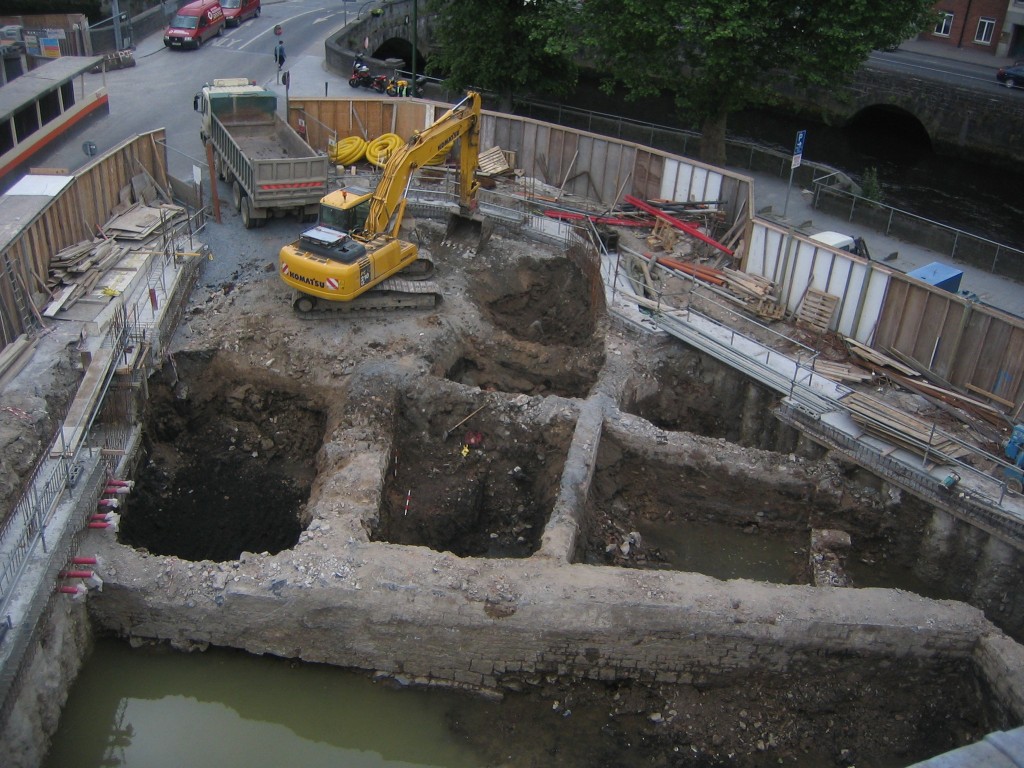
You never quite know what to expect when you venture into an archaeological project. In 2002, we were commissioned to undertake an archaeological assessment at Barrington´s Hostel in the centre of Limerick city. Initially it was believed that the location had high potential for preserved medieval archaeology. However, after documentary research and the excavation of test trenches, it became apparent that the site had been heavily developed by cellared buildings in the 19th century and all traces of earlier archaeology had been destroyed.
However this wasn’t the end of the story! The massive scale of the buried foundations was intriguing so we decided to explore the nature of these 19th century remains further, in order to determine just what kind of building stood on this site in the not so distant past.

The first edition of the Ordnance Survey map depicted a very strange looking building on the site around 1840. Historical research identified that this was none other than the Monte de Piété. This building served as a charitable pawn shop built by the Barrington family to support a nearby hospital. The Barrington´s were a wealthy local family who were renowned for undertaking charitable works and helping the poor of Limerick. Having determined the nature of the building that once stood on the site, we decided to look in more detail at all documentary sources pertaining to the building. On closer inspection we found to our amazement that the façade of the original pawn shop survived within the fabric of the wall forming the site boundary on Mary Street.

The name of the Monte de Piété and its concept originated in 15th century Italy, where it was associated with the charitable activities of the Franciscans as an alternative to more organized and extortionate money lending. The classical-style limestone building in Limerick, begun in 1836, and replete with a copper cupola, pillars, railings and a small grass enclosure, stood in the grounds of the hospital immediately southeast of where Barrington´s Hostel stands today. This was the first such institution in Ireland and was considered a great innovation at the time. In 1840 a Mr. Porter used the example of the Limerick Monte de Piété to advocate the widespread adoption of such institutions. In reality, it failed to make a profit and in 1845 it was closed. In the following years it was converted into a convalescent hospital and finally a police barracks. The building was demolished in 1847.
![BHL02 fig03v01 Mont de Piete pawnshop [Converted]](http://blog.rubiconheritage.com/wp-content/uploads/2012/09/bhl02-fig03v01-mont-de-piete-pawnshop-converted.jpg?w=300)
I know this area of Limerick quite well. I am fascinated by the Mont de Piété Pawnshop. Where exactly was it relative to the 1st picture picture of the corner site showing the 19th Century cellars ? Did that wall run up Mary Street ? And was the pawnshop in Mary Street ? Just a few years later (?) the famous prize winning ‘McNamara’s Band’ was also based in Mary Street.
A reminder of the lyrics :
Oh, me name is MacNamara, I’m the leader of the band
Although we’re few in numbers, we’re the finest in the land
We play at wakes and weddings and at every fancy ball
And when we play the funerals, we play the March from Saul
Oh, the drums go bang and the cymbals clang and the horns they blaze away
McCarthy pumps the old bassoon while I the pipes do play
And Henessee Tennessee tootles the flute and the music is somethin’ grand
A credit to old Ireland is MacNamara’s band
Right now we are rehearsin’ for a very swell affair
The annual celebration, all the gentry will be there
When General Grant to Ireland came he took me by the hand
Says he, “I never saw the likes of MacNamara’s Band”
Oh, the drums go bang and the cymbals clang and the horns they blaze away
McCarthy pumps the old bassoon while I the pipes do play
And Henessee Tennessee tootles the flute and the music is somethin’ grand
A credit to old Ireland is MacNamara’s band
Oh, my name is Uncle Julius and from Sweden I did come
To play with MacNamara’s Band and beat the big bass drum
And when I march along the street the ladies think I’m grand
They shout, “There’s Uncle Julius playin’ with an Irish band!”
Oh, I wear a bunch of shamrocks and a uniform of green
And I’m the funniest lookin’ Swede that you have ever seen
There is O’Brians, O’Ryans, O’Sheehans and Meehans, they come from Ireland
But, by yimminy, I’m the only Swede in MacNamara’s Band
Oh, the drums go bang and the cymbals clang and the horns they blaze away
McCarthy pumps the old bassoon while I the pipes do play
And Henessee Tennessee tootles the flute and the music is somethin’ grand
A credit to old Ireland is MacNamara’s band.
Came across your post while researching the Monte de Piete in Limerick, a wonderful read and I can sense your enthusiasm at the find too. It was a very interesting building and concept behind the founding of the building. It is a loss to the streetscape of the city.
Hi Sharon,
Many thanks- it was certainly one of the most interesting buildings we have looked at!
Kind Regards,
Damian.